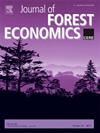Revisiting the Trade Restrictions-Industrialization Nexus in Developing Countries: The Case of Log Export Ban and Wood Processing
IF 0.7
4区 农林科学
Q3 ECONOMICS
引用次数: 0
Abstract
Many developing countries impose restrictions on the export of logs primarily to promote local wood processing. This study focuses on the Log Export Ban (LEB) policy and investigates if this policy impacts both the production and exports of two processed wood, i.e., sawnwood (first stage of processing) and veneer (second stage of processing). We implement the propensity score matching method to assess the average treatment effect on the treated (ATT) of the LEB policy in 101 developing countries. We find a positive and significant effect of the LEB policy on both sawnwood and veneer production while the effect is stronger in the case of sawnwood (about 4 percents) compared to veneer (about 1 percent). Moreover, we also find a positive and significant effect on the exports of sawnwood (around 10 percents) while we do not find any significant results on the exports of veneer. In addition, we investigate the heterogeneity in treatment effects using control function with some institutional variables such as the level of corruption, the quality of law and order as well as the bureaucracy quality. The results found are comparable to the ATTs results. Also, to avoid endogeneity issue, we apply the two-step GMM estimation model that confirms the ATTs results. Taking together, these results suggest than the LEB policy has mainly contributed to improve the first stage of wood processing rather than the second stage.重新审视发展中国家的贸易限制与工业化关系:以原木出口禁令和木材加工为例
许多发展中国家限制原木出口,主要是为了促进当地木材加工。本研究的重点是原木出口禁令(LEB)政策,并调查该政策是否影响两种加工木材的生产和出口,即锯木(加工的第一阶段)和贴面(加工的第二阶段)。我们实施倾向得分匹配方法来评估101个发展中国家的LEB政策对被治疗(ATT)的平均治疗效果。我们发现LEB政策对锯木和单板生产都有积极而显著的影响,而锯木(约4%)的影响比单板(约1%)更强。此外,我们还发现对锯木的出口有积极和显著的影响(约10%),而对单板的出口没有发现任何显著的结果。此外,我们还利用控制函数考察了腐败程度、法律和秩序质量以及官僚质量等制度变量对治理效果的异质性。所发现的结果与ats的结果相当。此外,为了避免内生性问题,我们应用了两步GMM估计模型来确认ats的结果。综上所述,这些结果表明,LEB政策主要有助于改善木材加工的第一阶段,而不是第二阶段。
本文章由计算机程序翻译,如有差异,请以英文原文为准。
求助全文
约1分钟内获得全文
求助全文
来源期刊

Journal of Forest Economics
农林科学-林学
CiteScore
1.70
自引率
0.00%
发文量
16
审稿时长
>36 weeks
期刊介绍:
The journal covers all aspects of forest economics, and publishes scientific papers in subject areas such as the following:
forest management problems: economics of silviculture, forest regulation and operational activities, managerial economics;
forest industry analysis: economics of processing, industrial organization problems, demand and supply analysis, technological change, international trade of forest products;
multiple use of forests: valuation of non-market priced goods and services, cost-benefit analysis of environment and timber production, external effects of forestry and forest industry;
forest policy analysis: market and intervention failures, regulation of forest management, ownership, taxation;
land use and economic development: deforestation and land use problem, national resource accounting, contribution to national and regional income and employment.
forestry and climate change: using forestry to mitigate climate change, economic analysis of bioenergy, adaption of forestry to climate change.
 求助内容:
求助内容: 应助结果提醒方式:
应助结果提醒方式:


